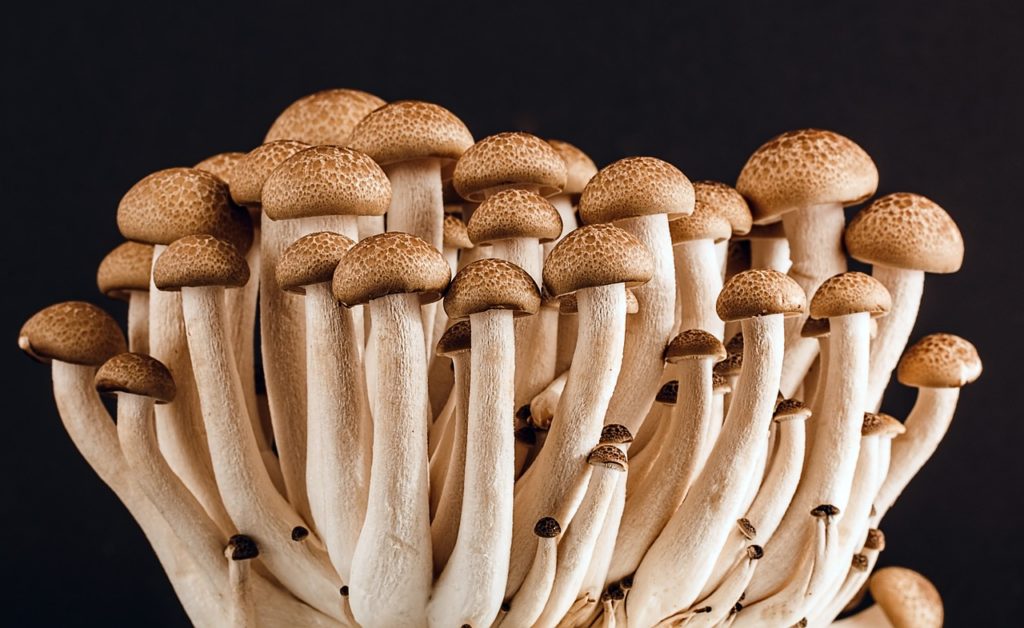Mushrooms are members of the fungi kingdom, which is estimated to have 2 to 4 million different species. It’s one of the most diverse groups around! That being said, most of us know only grocery store varieties such as crimini, portabella, or button. These varieties offer great nutritional benefits, but there are so many more beneficial mushrooms out there. Other cultures, especially in Asia, have ventured deeper into mushroom cuisine, and some delicious highlights include enoki, wood ear, and shiitake. Two of my favorite mushrooms also happen to be used frequently in TCM: lion’s mane and cordyceps.
Lion’s mane mushroom is a traditional Chinese herb known as hou tuo gu and has been used for thousands of years. This mushroom gets its name from its billowing white fibrous strands that look like a lion’s mane. It has been shown to increase the synthesis of nerve growth factor or NGF.1 Through increased synthesis of NGF, there may be enhanced recovery from nerve damage or nerve injury, which may be a benefit to patients suffering from dementia or Alzheimer’s, or to healthy people looking to support brain and general memory. Additionally, lion’s mane could decrease neuronal damage caused by the build-up of amyloid-beta plaques associated with Alzheimer’s disease.2
Another mushroom that has been used in Chinese medicine for thousands of years is cordyceps. In China, it was used for fatigue and low libido, and valued for anti-aging properties. Studies have shown that cordyceps improves the way our bodies utilize and deliver oxygen to cells. In other words, cordyceps increases VO2 max, improving athletic endurance.3 Cordyceps also increases the amount of ATP produced in muscle cells, which can help with performance. Some of the traditional Chinese anti-aging claims may hold some truth. In studies with mice, cordyceps mushroom prolonged lifespan by several months.4
Medicinal mushrooms like my two favorites largely provide health benefits because of their polysaccharide, glycoproteins, and proteoglycans content. Mushrooms in supplement form are becoming quite popular, and many more studies recognizing the potential health benefits are coming out. Lion’s mane and cordyceps are two beneficial medicinal mushrooms of many. Other fungi of interest include chaga, turkey tail, and reishi. TCM values mushrooms as herbal medicine and subsequently many licensed acupuncturists include them in their formulas. Before modern times, it was possible mushrooms were consumed more frequently. Therefore, mushrooms may have played a important role in human health that we may be missing out on today.
Want to add them to your dietary routine? Eating several servings of mushrooms during meals is great, but there are other ways to increase your fungi consumption. Adding a mushroom extract or powder to your coffee or morning smoothie is an easy way to boost your intake. As mushrooms become more and more popular, the variety of brands increase. Try to make sure the mushroom product is organic and went through a hot water extraction to ensure the right compounds are extracted. I like to add mushrooms to my coffee in the morning. To make this, I will mix a mushroom powder into my coffee with honey, frothed oat milk, and cinnamon. Alternatively, I will add dried raw reishi into boiling water to extract the compounds. Then I’ll add this water into my French press for making coffee. Reishi is another calming and relaxing mushroom, which I find balances out the jitteriness of coffee.5
5. Ganoderma lucidum (Lingzhi or Reishi)
[written by Katie]
